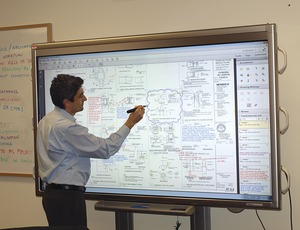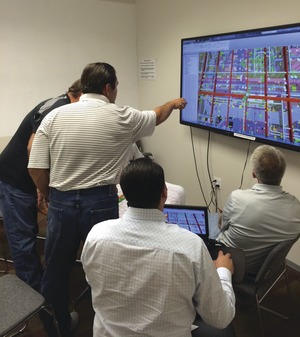

California's Office of Statewide Health Planning and Development is piloting real-time electronic plan review and submittal for two San Francisco hospital projects, which have a combined price tag of $2.7 billion and are scheduled for completion in 2018.
Sutter Health, the owner, asked "us to pilot some tech they had, and it was new to us, so we jumped on it," says Eric Reslock, OSHPD's assistant director for legislative and public affairs. "The idea is to speed up review."
First opened in 2011, OSHPD's electronic plan-review portal accepts PDFs, but only for new projects valued at less than $175,000—"not for something like a brand-new hospital," says Andy Sparapani, BIM director at Herrero- BOLDT, which is a partnership of San Francisco-based firms Herrero Builders and The Boldt Co.
With a commitment from Sutter Health, OSHPD agreed to real-time electronic review for the architecture and exterior-wall and MEP systems for St. Luke's Campus Replacement Hospital and a California Pacific Medical Center Van Ness and Geary Campus hospital.
Finding the right software took trial and error, says Sparapani. The team landed on Bluebeam Revu for markups and Bentley's ProjectWise for linking to the archived sheets. But getting everyone on the same technological page posed workflow challenges. "The benefit of digital review is that communications can occur in real time, any time in the review process," says architect Arlee Monson of SmithGroupJJR, which is the architect for both projects. "The challenges are in developing processes that respond to a new way of working."
HerreroBOLDT went through several tests to get the processes right, says Sparapani. "At first, our electronic process was harder than the physical processes," he notes. Workflow improved after his crew sat down with OSHPD workers in their cubicles to learn firsthand about their review processes, he says. "If you want to change a culture, you have to really understand its processes and the people doing the work," says Juan Restrepo, HerreroBOLDT's OSHPD commissioning manager. "Don't talk to people in legal [departments]—the ones making decisions—but [talk to] the ones reviewing the documents."
Work has sped along since the right processes were put in place, Sparapani reports, adding that the system has reduced by months the time previously spent waiting. More than once, his team has spotted a comment that was significant enough to halt a portion of the review for corrective actions. If the review had been paper-based, "we would have waited until the duration of the review [to find out they] stopped 10 sheets in," says Sparapani. Such a process could have taken six months, he says.
But with the electronic process, the HerreroBOLDT team was immediately made aware of an issue and, within three weeks, completed revisions and restarted the review for the problem section. OSHPD's Reslock says electronic rapid review reduces time spent on oversight by an average of 35%. The agency hopes to launch a statewide pilot in 2015.


Post a comment to this article
Report Abusive Comment